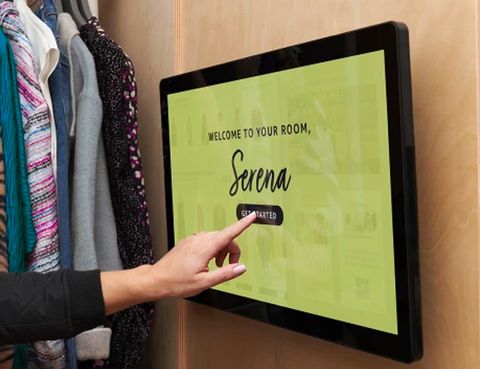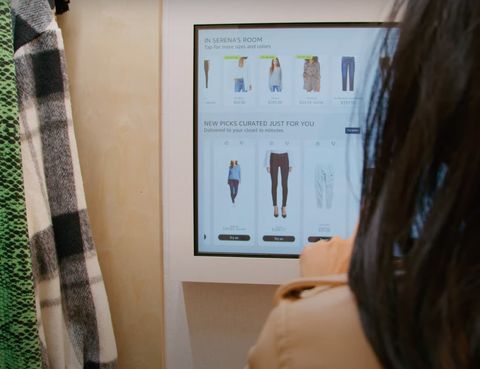Are you eager for even more Amazon in your life? The online shopping giant, heralded for upheaving the retail industry and upping our collective appetites for easy shopping and fast shipping, wants its full circle moment. First, it was an innovative alternative to visiting a store in-person. Now, Amazon wants foot traffic inside its own fleet of brick-and-mortar stores: Amazon Books, where, you guessed it, customers can shop the newest titles; Amazon Fresh, a place for groceries, prepared foods and alcohol; Amazon Pop Up, the Internet oligarchy’s attempt at conceptual retail; Amazon 4-Star, where only the highest-rated products are placed; Amazon Go, a quicker, convenience store-style spot; and, now, Amazon Style, a store solely dedicated to apparel and shoes.
Although Amazon retail stores likely would’ve sounded like an ironic meme no more than 10 years ago — Amazon piloted its first in-person store in 2015 — they will surely be a primary focus for the company moving forward. While Amazon will claim about 45-percent of all e-commerce transactions this year, it will likely only account for roughly 10-percent of all retail sales. But that number is up from near 3-percent in 2017, meaning if Amazon keeps this pace it’ll pass Walmart as the US’ largest retailer — both online and in-person.
Amazon inching closer to overtaking Walmart, I’d argue, is incentive enough for the company to keep going. We’re destined to see Amazon stores on more corners and anchoring more new-age malls. But what’s that mean for you, the customer? Technological headaches and lackluster excess in the name of innovation. Amazon says its newest chain, Amazon Style, which will debut in Los Angeles’ Glendale suburb (at The Americana at Brand), will be at the forefront of retail technology. It’ll offer everything you can already find and order on Amazon but in their physical forms, meaning you can try items on, sift through their different colors and sizes and check out — all from your phone (as long as you’ve downloaded the Amazon Shopping app).
Unlike at Whole Foods, there won’t be special discounts for Prime Members. In fact, the shopping experience will be the same, at least they say so right now, for members and non-members alike. Everyone will be able to scan the QR codes presented alongside each style and order items to a pre-determined dressing room just for them. If you dig what you’ve tried on, you can send it to the checkout counter with a few taps inside the app, saving you those crucial few minutes you would’ve otherwise spent pulling out your wallet and paying, waiting for the receipt to print and the cashier to load your bag. Convenience.
Inside the fitting rooms, there are tablet screens that let you do much of the same. You won’t need to send a friend or your kid across the store to fetch a different size if the one you pulled didn’t fit; an Amazon employee will do that for you. I understand Amazon’s intent: If customers can try on the clothes they’re interested in before buying them, they’re more likely to enjoy them and thus wear them, too; and far less likely to return their order. But if Amazon doesn’t have ambitions of opening more of these, what’s the point? Most customers will continue buying $6 dollar T-Shirts they don’t really like, $14 dollar sweatpants they’ll wear for three weeks, $45 dollar sneakers they’ll have to replace in a year.
Amazon plans for Amazon Style to stock items at a range of prices — cheap basics, as they call them, all the way up to $400+ dollar statement pieces. They hope this will attract a broader array of customers and encourage more purchases, no matter if the person’s filled a $14 dollar cart or a $4,000 dollar one. But the best part about brick-and-mortar shopping is finding a store that resonates with you and fuels your own personal style, not diverting you away from new and interesting designers in favor of what everyone else is wearing. I, for one, will probably steer clear of Amazon Style unless I’m curious — or in need of new socks or plain white undershirts. But isn’t that what Amazon.com is for? Unless Amazon has grand plans to lure newer and better brands into Amazon Style, I’d have to expect 30,000 square feet of Amazon Essentials, Hanes, Gildan, Carhartt, Under Armour and Wrangler Authentics, all of which hold the top spots on Amazon’s digital style store, Amazon Fashion. Ugh.
This content is created and maintained by a third party, and imported onto this page to help users provide their email addresses. You may be able to find more information about this and similar content at piano.io


